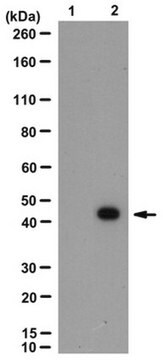M3807
Anti-MAP Kinase, Non-Phosphorylated ERK antibody, Mouse monoclonal
clone ERK-NP2, purified from hybridoma cell culture
Synonyme(s) :
Anti-ERK, Anti-ERK-2, Anti-ERK2, Anti-ERT1, Anti-MAPK2, Anti-NS13, Anti-P42MAPK, Anti-PRKM1, Anti-PRKM2, Anti-p38, Anti-p40, Anti-p41, Anti-p41mapk, Anti-p42-MAPK
About This Item
Produits recommandés
Source biologique
mouse
Conjugué
unconjugated
Forme d'anticorps
purified from hybridoma cell culture
Type de produit anticorps
primary antibodies
Clone
ERK-NP2, monoclonal
Forme
buffered aqueous solution
Poids mol.
antigen, ERK-1 44 kDa
antigen, ERK-2 42 kDa
Espèces réactives
human, rat
Concentration
~2 mg/mL
Technique(s)
immunocytochemistry: suitable
indirect ELISA: suitable
microarray: suitable
western blot: 5-25 μg/mL using rat brain extract
Isotype
IgG1
Numéro d'accès UniProt
Conditions d'expédition
dry ice
Température de stockage
−20°C
Modification post-traductionnelle de la cible
unmodified
Informations sur le gène
human ... MAPK1(5594) , MAPK3(5595)
rat ... Mapk1(116590) , Mapk3(50689)
Catégories apparentées
Description générale
Spécificité
Immunogène
Application
Forme physique
Notes préparatoires
Clause de non-responsabilité
Not finding the right product?
Try our Outil de sélection de produits.
Code de la classe de stockage
10 - Combustible liquids
Classe de danger pour l'eau (WGK)
nwg
Point d'éclair (°F)
Not applicable
Point d'éclair (°C)
Not applicable
Certificats d'analyse (COA)
Recherchez un Certificats d'analyse (COA) en saisissant le numéro de lot du produit. Les numéros de lot figurent sur l'étiquette du produit après les mots "Lot" ou "Batch".
Déjà en possession de ce produit ?
Retrouvez la documentation relative aux produits que vous avez récemment achetés dans la Bibliothèque de documents.
Notre équipe de scientifiques dispose d'une expérience dans tous les secteurs de la recherche, notamment en sciences de la vie, science des matériaux, synthèse chimique, chromatographie, analyse et dans de nombreux autres domaines..
Contacter notre Service technique








